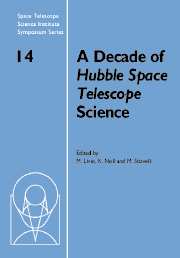Book contents
- Frontmatter
- Contents
- Participants
- Preface
- HST studies of Mars
- HST images of Jupiter's UV aurora
- Star formation
- SN1987A: The birth of a supernova remnant
- Globular clusters: The view from HST
- Ultraviolet absorption line studies of the Galactic interstellar medium with the Goddard High Resolution Spectrograph
- HST's view of the center of the Milky Way galaxy
- Stellar populations in dwarf galaxies: A review of the contribution of HST to our understanding of the nearby universe
- The formation of star clusters
- Starburst galaxies observed with the Hubble Space Telescope
- Supermassive black holes
- The HST Key Project to measure the Hubble Constant
- H0 from Type Ia supernovae
- Strong gravitational lensing: Cosmology from angles and redshifts
HST's view of the center of the Milky Way galaxy
Published online by Cambridge University Press: 13 August 2009
- Frontmatter
- Contents
- Participants
- Preface
- HST studies of Mars
- HST images of Jupiter's UV aurora
- Star formation
- SN1987A: The birth of a supernova remnant
- Globular clusters: The view from HST
- Ultraviolet absorption line studies of the Galactic interstellar medium with the Goddard High Resolution Spectrograph
- HST's view of the center of the Milky Way galaxy
- Stellar populations in dwarf galaxies: A review of the contribution of HST to our understanding of the nearby universe
- The formation of star clusters
- Starburst galaxies observed with the Hubble Space Telescope
- Supermassive black holes
- The HST Key Project to measure the Hubble Constant
- H0 from Type Ia supernovae
- Strong gravitational lensing: Cosmology from angles and redshifts
Summary
The Galactic Center has been the subject of a variety of HST observing programs, mainly since the installation of NICMOS. The observational strengths of NICMOS lie with its sensitivity and very stable point spread function which enables a variety of studies including sensitive searches for variable sources and accurate colors across the 1 to 2.5 µm region. The emission line filters in NICMOS enable studies of the interstellar medium and a search for [SiVI] emission as a ‘smoking gun’ for gas clouds near a black hole powered accretion disk.
Introduction
The center of the Milky Way is of course the closest galaxy nucleus and is a natural area to choose to study in detail. The discovery of a peculiar radio source, SgrA*, and the subsequent demonstration that it is a black hole has only heightened interest in the center. Figure 1 shows a contour plot at 1.04 µm compared to a NICMOS image at 1.45 µm which clearly shows why the Galactic Center requires use of infrared instrument like NICMOS with Av ∼ 30 while AK ∼ 3.3.
The Galactic Center has been studied with HST from the first observing cycle using WFPC proposed in an era where the nature of many of the stars was not understood, and the existence of a cluster in very close proximity to the black hole, SgrA*, was unknown.
Information
- Type
- Chapter
- Information
- A Decade of Hubble Space Telescope Science , pp. 119 - 127Publisher: Cambridge University PressPrint publication year: 2003
